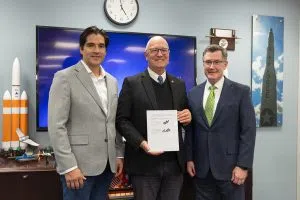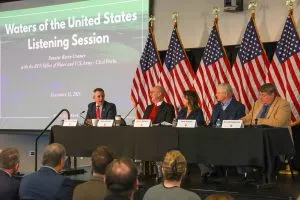
Utilities that operate in North Dakota will benefit as $7.3 billion in federal funding is announced for rural clean energy investments. (Kyle Martin/For the North Dakota Monitor)
(North Dakota Monitor) -Three utilities that operate in North Dakota will be among 16 rural electric power cooperatives sharing in $7.3 billion from the federal government for clean energy projects that President Joe Biden will announce when he visits western Wisconsin Thursday.
The funds come from the 2022 Inflation Reduction Act, which included $13 billion in rural electrification programs administered by the U.S. Department of Agriculture (USDA).
That represents “the largest investment in rural electrification since 1936 and the New Deal,” Agriculture Secretary Tom Vilsack told reporters in a briefing Wednesday ahead of the announcement.
The funds expected to be announced Thursday are under the USDA’s Empowering Rural America program, dubbed New ERA. The New ERA federal grants and loans are projected to seed another $29 billion in private investment to produce more than 10 gigawatts of clean energy for rural communities — enough to power about 4 million homes according to one federal estimate.
Minnkota Power Cooperative, Basin Electric Power Cooperative and Great River Energy are among the recipients, but the dollar amounts of the awards were not immediately released.
Erin Oban, state director of USDA Rural Development in North Dakota, noted that all three utilities are either based in North Dakota or have a significant presence serving rural North Dakota.
“Our country’s investments in rural electric system infrastructure, renewable energy, and modern technologies are critical investments in future generations of rural North Dakotans,” Oban said in a statement. “These co-ops continue to show their commitment to ensuring that our most rural hometowns and neighbors have access to reliable, affordable electricity.”
Minnkota Power Cooperative will use the funding to support Project Tundra, a carbon capture and storage project proposed for Milton R. Young Station in central North Dakota, as well as the procurement of 370 megawatts of wind energy in North Dakota, according to information released by the White House.
“New ERA helps not-for-profit cooperatives like Minnkota more cost-effectively decarbonize power supply portfolios, while retaining a reliable and resilient electric grid for the members we serve,” Minnkota President and CEO Mac McLennan said in a statement.
Basin Electric Power Cooperative will use the funding to procure additional renewable energy generation and enhance existing cooperative-owned renewable assets, which are expected to total more than 1,400 megawatts across North Dakota, South Dakota and Montana.
Renewable energy is a “key portion” of Basin Electric’s approach to resource development, Basin Electric Power Cooperative CEO and General Manager Todd Brickhouse said in a statement.
Great River Energy and its member owners plan to use the investment to procure 1,275 megawatts of renewable energy across rural portions of North Dakota and Minnesota, including large-scale wind projects.
Biden will make the announcement Thursday in the community of Westby, southeast of La Crosse.
The 16 power co-ops taking part serve residents in 23 states. The initiative will “bring the promise of clean energy and lower costs to approximately 5 million rural households, representing 20% of the nation’s entire rural households, as well as farms and businesses that are located in those 23 states,” Vilsack said.
Collectively the 16 co-ops benefiting from the program are projected to add 4,500 jobs in addition to 16,000 construction jobs created for the work, according to the USDA. The projects include 3,700 megawatts of wind power, 4,700 MW of solar power, 800 MW of nuclear power and 357 MW of hydropower.
“All of this is designed not only to provide more reliant electricity for those rural communities, but will also result in a 43.7-million-ton annual reduction of greenhouse gas emissions,” Vilsack said.
All projects funded through the Inflation Reduction Act must be fully completed by Sept. 30, 2031, according to administration officials.
The New ERA program is limited to rural electric cooperatives. Another USDA program, PACE (Powering Affordable Clean Energy), also funded through the Inflation Reduction Act, provides low-interest loans to rural energy providers for clean energy and energy storage projects. Vilsack said USDA has made 19 awards nationally under that program, totaling $665 million.
The Inflation Reduction Act also expanded the Rural Energy for America Program (REAP), which provides grants and loans to farmers and rural small businesses installing renewable energy systems or undertaking energy efficiency projects. The Biden administration has so far put $2.2 billion into that program, covering 7,600 projects.
This story was updated to add comment from Erin Oban, state director of USDA Rural Development in North Dakota.
____________________________________________________









